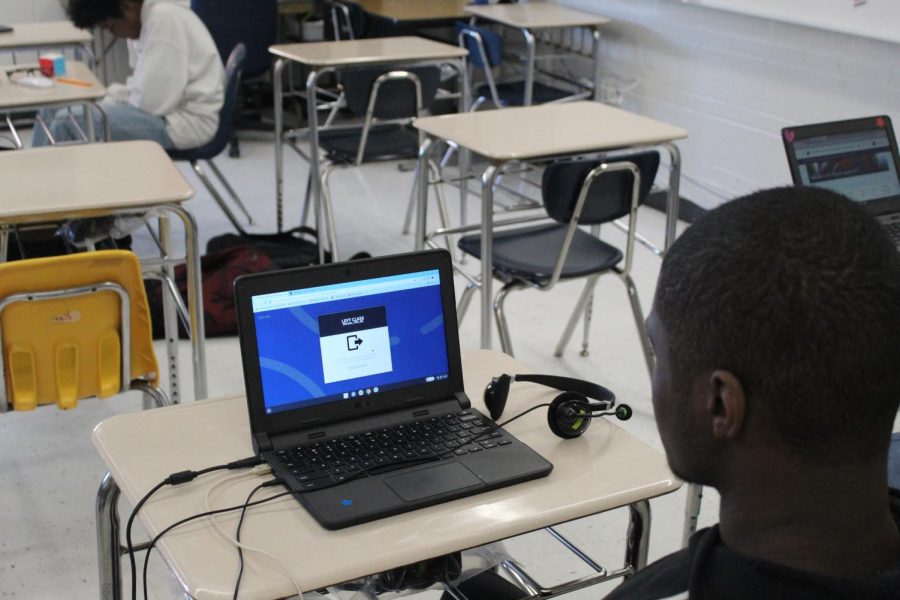Nationwide teacher shortage hits home as Hawks navigate in-person virtual learning
Freshman Michael Terry sits in his Spanish 1 class, which is being taught online by a Stride teacher. Michael goes to class and has a teacher in the room, but the instruction is virtual.
November 10, 2022
In person class but, on your computer? Some schools in the Hazelwood School District have a new type of learning. Some middle and high school students were assigned to virtual learning classes at the beginning of the 2022-23 school year. In these classes students learn from a virtual teacher off their computers.
Virtual learning classes are programmed through an app called K-12 learning solutions or Stride. Students log in through an app on their computer called Clever and join the video call to meet with their teachers for the class. All assignments and any other necessary pieces of work can be found in the contents tab of their online course.
“We hired a company called Stride to fulfill the certified educator (role), the person in the class is a long term facilitator. During their off period they plan and discuss things behavioral in the classroom,” explained Josh Fullerton, associate principal.
This form of learning has been new and different for all to adjust to. For students like sophomore Aniyah Cannady, virtual learning has not been the best choice of learning for her.
“Virtual learning is not ideal, especially in a class full of people who are not willing to learn like you are,” explained Cannady.
Aniyah Cannady also adds being in school learning off computers is the issue especially in a disruptive class environment.
“I don’t feel good about virtual learning at all. The teacher is not the issue but it’s the fact that we are in school and having to learn off of our Chromebooks.– Also the atmosphere is pretty loud and most of the time I can barely hear the teacher,” she said.
Though most students are still getting used to the new type of learning virtual class, facilitators like Scott Gartland are hopeful that more students will become flexible to the program.
“So far, it feels like most students have become comfortable with the way that the learning flows, and the flexibility that an online course can allow. There are certainly some students who have had a little more difficulty with the adjustment, but I think that the more that we are able to work with those individual students to find the best way for them to learn and master the material, the better off the classroom will be for everyone,” explained Gartland.
Other students, like sophomore Sommer Green, don’t necessarily want to be in the class but are making efforts to pass.
“I don’t feel like I’m learning anything at all but its’s an easy class to pass. I wanted to get switched out honestly but I stayed in there anyways,” said Green.
Virtual classes weren’t the ideal way for learning with students this year, but are necessary due to the country-wide teacher shortage.
“The unfortunate teacher shortage has not allowed us to hire the certified educator,” said Fullerton. “The human resources department would like us to hire someone certified in the area if it is possible, so it is a possibility an in-person teacher would take the job mid-year.”
High school students aren’t the only ones going through changes of having an online class. Middle schoolers like Miaya Jackson, an 8th grader at Hazelwood North Middle, have also had frustrations with their experiences of having a virtual teacher and adds that her capability to use the Stride app was easy but logging in everyday was her issue.
“Learning how to use the Stride site wasn’t hard at all but its annoying having to log onto the site everyday,” she stated.
Learning to adjust to in class virtual learning is a change for all students in the district that partake in this form of learning.
“Virtual learning has already impacted me, like I’m more appreciative of towards my teachers because their actually here helping me physically and I don’t take my teachers for granted like that anymore,” said Jackson.
